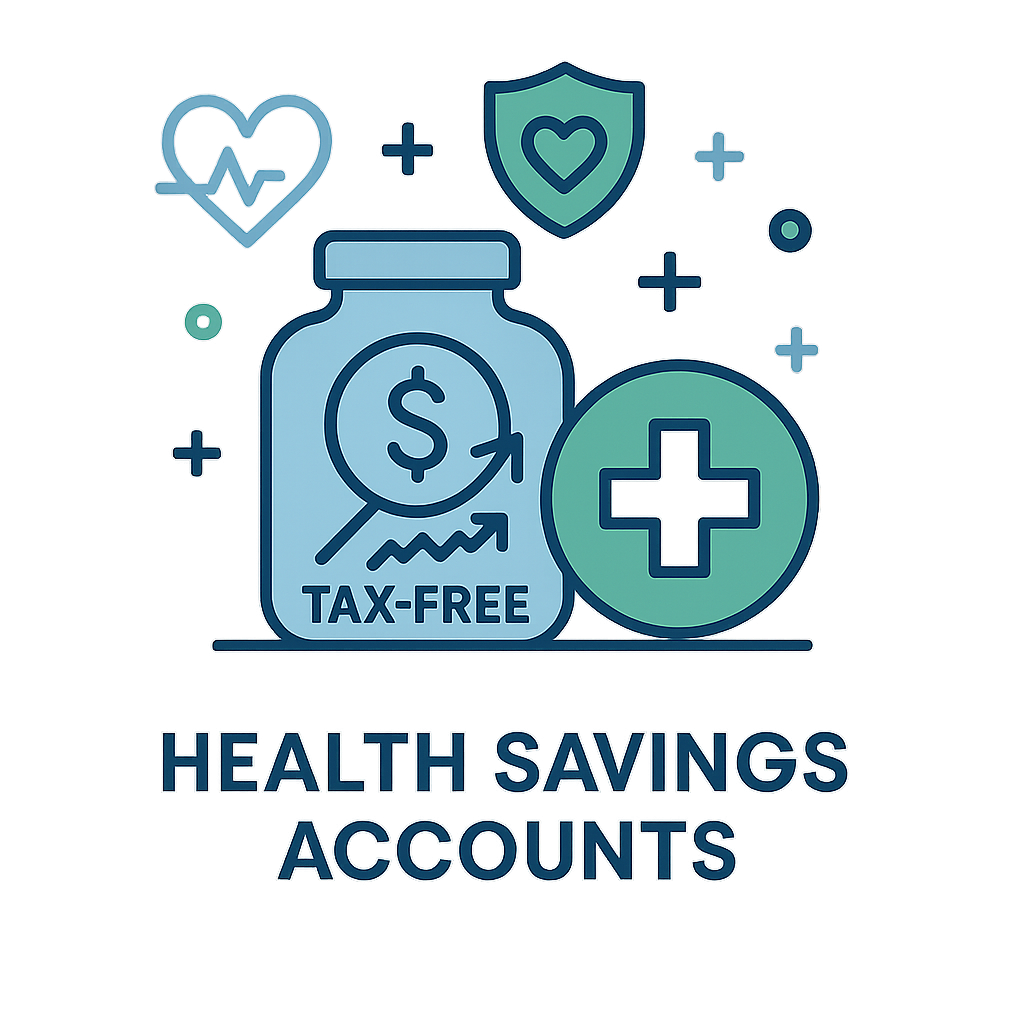Introduction
Health Savings Accounts (HSAs) have really changed over the years, becoming a key part of modern employee benefits in 2025. Smart employers across the United States and Canada are realizing that HSAs give them a competitive edge and boost financial wellness, especially with recent legislative updates. Getting to know the latest improvements and strategies for HSA savings accounts can help your organization improve its healthcare benefits, increase engagement, and attract the best talent.
What is an HSA?
A Health Savings Account (HSA) is a special savings account with tax advantages for people with a high-deductible health plan (HDHP). It allows employees to put money away before taxes for qualified medical expenses. What makes it special is its triple-tax benefit: the money you put in, the growth from investments, and the money you take out for eligible costs are all tax-free. Because the account belongs to the employee, it can move with them from job to job, and any money left over at year-end simply stays in the account rather than expiring.
For employers, this structure makes HSAs an elegant way to promote smarter health spending. Employees learn to plan for deductibles and routine care, while the tax advantages help stretch every dollar. When paired with clear education and easy-to-use tools, HSAs become a compelling pillar of a modern benefits strategy that supports both day-to-day healthcare needs and long-term financial well-being.
How Does an HSA Work?
HSAs are paired with HSA eligible health plans. Both employees and employers can add money to the account. The employee is the owner of the account and can use the funds for things like deductibles, prescriptions, and dental or vision care. The best part is, the money rolls over every year, never expires, and can even be invested to grow over time. In practice, many employers contribute “seed” funds or match a portion of employee contributions, which helps participants build balances faster and reduces the financial strain of early-year medical expenses.
Operationally, employees can spend from their HSA with a debit card or through reimbursements after submitting receipts. If the plan allows investments, balances above a required threshold can be directed into mutual funds or similar vehicles, allowing tax-free compounded growth for future healthcare needs. Withdrawals for non-qualified expenses are taxable and may incur penalties, so education and clear communication remain essential for high engagement and compliance.
The 2025 HSA Landscape: Critical Legislative Changes
Some big legislative changes in 2025, particularly the One Big Beautiful Bill Act (OBBBA), have broadened HSA benefits for everyone and made plan design more flexible. Together, these updates are designed to expand access, reduce barriers to care, and modernize how people use HSAs alongside evolving healthcare delivery models.
Permanent Telehealth Coverage Expansion: Now, all HDHPs can cover telehealth services from the first dollar without messing up HSA eligibility. This is a permanent change for 2025 and beyond, making virtual care easier to access and encouraging preventive health while keeping the account in good standing. Employers can highlight this feature to promote early intervention and convenient access to care.
Broader Plan Access: Starting in 2026, bronze and catastrophic plans on the ACA exchanges will be considered HDHPs. This will make many more employees eligible for HSAs. Organizations with a mix of full-time, part-time, and seasonal workforces may see a larger share of employees qualify, improving equity and participation in tax-advantaged saving.
Direct Primary Care Inclusion: Direct Primary Care agreements are now considered an eligible medical expense for HSAs. You can use up to $150 a month for an individual or $300 a month for a family, and these amounts will be adjusted for inflation starting in 2026. This change encourages proactive, relationship-based care and makes the HSA an even more practical tool for day-to-day health management.
Expanded Medical Expense Definitions: The official definition of what counts as a qualified medical expense is getting broader. There will also be higher HSA contribution limits and more flexibility for lower-income employees, helping support a more holistic approach to health spending. Employers should prepare communications that clearly outline what’s new so employees can confidently use their benefits.
Essential HSA Benefits for Employers in 2025
1. Triple-Tax Advantage for Employees
The HSA’s hallmark is its threefold tax advantage: contributions are tax-deductible, account earnings grow tax-free, and qualified withdrawals are also tax-free. This powerful combination makes the HSA one of the most effective tools for healthcare savings. Employers who emphasize this in recruitment and onboarding materials can set their offering apart, especially for cost-conscious candidates comparing total compensation packages.
Because contributions reduce taxable income and investment growth is shielded, employees often view HSAs as a secondary retirement vehicle for future healthcare costs. Over time, balances can serve as a buffer against rising premiums and out-of-pocket expenses, reinforcing perceived value and loyalty to employers that support long-term financial security.
2. Flexible Employer Contribution Options
Employers can contribute in several ways, which boosts the plan’s value and gets employees more involved. You can implement matching contributions up to a limit to nudge employees toward regular saving. You can also reward wellness activity—such as completing a dental cleaning or joining wellness coaching—and direct those incentives to HSAs for a tangible, health-aligned benefit. Leading benefits platforms like GoKlaim make it easy to track and automate these contributions. Initial seed funds for new hires, as well as recurring monthly or annual deposits, ensure participants have funds available when they need care, lowering financial barriers and driving adoption.
3. Enhanced Employee Retention and Recruitment
A great HSA account program can make all the difference for top talent. In 2025, about 42% of employees said they would consider switching jobs for better benefits, with Gen Z and Millennials being the most influenced. When candidates see clear employer contributions, investment options, and simple administration, the HSA becomes a headline feature of the offer. Over time, participation analytics can also inform workforce planning and reveal which incentives resonate most with different employee segments.
4. Lifelong Ownership and Portability
Unlike FSAs, employees own their HSAs. The money is theirs to keep, even if they change jobs or retire. This portability is a huge selling point and supports long-term financial health. From the employer’s perspective, it reduces the end-of-year rush to spend funds and aligns incentives toward prudent, planned healthcare consumption. Communicating this ownership clearly helps employees appreciate the enduring value of each contribution.
5. Rollover and Investment Potential
HSA funds roll over every year, which allows for compounding growth. Many providers, including GoKlaim, offer HSA investment options, letting the funds grow tax-free, much like a retirement account. As balances rise, employees are more likely to invest amounts above their comfort-level cash threshold, which can meaningfully grow future healthcare purchasing power and reduce stress around unexpected medical bills.
6. Wide Range of Eligible Expenses
HSAs can be used for a wide variety of healthcare costs, from deductibles to dental, vision, preventive care, and now, direct primary care services. The expanding list of HSA eligible expenses makes these accounts more useful than ever. Employers should regularly update their benefits guides so employees know how to use funds confidently for everyday needs and new eligibility categories.
7. Strategic Integration with Wellness Programs
You can connect HSAs with corporate wellness platforms, such as GoKlaim, to automate incentive tracking, link health spending with broader wellness goals, and simplify the overall employee benefits administration. This integration streamlines compliance, enhances visibility into program ROI, and helps HR teams align financial incentives with desired behaviors like preventive visits, physical activity, or chronic condition management.
HSA Contributions and Rules in 2025
For 2025, contribution parameters remain generous and continue to support long-term savings. For an Individual, the contribution limit is $4,150 (projected), with rollover that is unlimited and non-expiring. Employers can support these accounts through matching, seed contributions, wellness rewards, or recurring funding. For a Family, the contribution limit is $8,300 (projected), also with unlimited, non-expiring rollover, and all the same employer funding options available. For those 55 and older, a catch-up contribution of an additional $1,000 is allowed, again with unlimited rollover and access to all employer contribution strategies. These projections help employees plan, though final figures are set by the IRS each year.
Note: Final IRS limits may vary. Always check with your benefits administrator or provider.
HSA Investment Options for Employees
Today’s HSA experience goes beyond simply parking cash for short-term expenses. Many programs allow investing in mutual funds, stocks, ETFs, or money market accounts once a minimum cash balance is met. Allowing employees to invest helps them grow their healthcare savings over the long term, which is especially useful as more people use HSAs as a secondary retirement savings tool. Employers should provide simple, jargon-free education on risk, fees, and time horizon so employees can choose options that fit their needs.
Eligibility: Who Can Open an HSA?
Eligibility rules are straightforward but important. An employee must be covered by a qualified HDHP, which—beginning in 2026—will include new bronze and catastrophic plans on the exchanges. They cannot be enrolled in other non-HDHP coverage (with some exceptions), and they cannot be claimed as a dependent on someone else’s tax return. It’s important for employers to clearly explain who is eligible and help employees enroll to get the most participation, especially during open enrollment and new-hire onboarding.
HSA vs FSA vs HRA: Comparison Table
When comparing account types, ownership is a key differentiator: an HSA is owned by the employee, while both FSAs and HRAs are owned by the employer. Portability follows ownership—HSAs are portable, whereas FSAs and HRAs typically are not. Rollover rules also diverge: HSAs offer unlimited rollover, while FSAs and HRAs generally have limited carryover or grace-period provisions defined by the employer.
Funding sources vary as well. HSAs accept both employee and employer contributions, FSAs are mostly employer-funded with optional employee deferrals depending on plan design, and HRAs are funded solely by the employer. Investment capability is another major separator: HSAs commonly allow investments, while FSAs and HRAs do not. In terms of qualified expenses, HSAs now cover extensive categories including DPC and telehealth—while FSAs generally cover medical expenses and HRAs are restricted to employer-defined uses. Finally, eligibility for HSAs requires enrollment in an HDHP, whereas FSAs and HRAs follow employer-specific rules. When you look at the HSA vs FSA debate, HSAs clearly come out on top, especially when managed through a top-tier employee benefits platform. They offer better longevity, tax benefits, and investment opportunities.
Best Practices for Employers: Maximizing HSA Value
Use employer contributions to attract and keep great talent. Advertise seed, match, and reward structures during recruiting and reinforce them during onboarding so employees immediately see and feel the value. Promote the expanded plan options, like bronze/catastrophic plans, telehealth, and DPC. Clear explanations help employees understand what’s covered from day one. Automate administration with platforms like GoKlaim to save time and reduce errors. Automation reduces manual work, improves compliance, and enhances the employee experience. Educate your employees on the tax advantages, eligible expenses, and investment opportunities. Ongoing education increases confidence and responsible use. Integrate HSA incentives into your wellness programs to align with your overall benefits strategy. Tie rewards to preventive care and chronic condition management to drive measurable outcomes.
GoKlaim: Streamline HSA and Wellness Spending Administration
GoKlaim provides a seamless way to manage health savings accounts, wellness spending, and other employee reimbursement programs. By integrating these benefits, HR teams can automate compliance, connect HSA savings to holistic wellness goals, and simplify benefits administration, which is perfect for companies in North America that want to offer maximum value and convenience. Consolidating tools and data makes it easier to report on participation, identify gaps in understanding, and refine contributions or incentives over time.
Regional Insights: HSAs in North America
United States: HSAs are a central part of employee benefits, and they are becoming even more flexible and accessible thanks to updated federal laws. Employers can leverage the permanence of telehealth coverage and the inclusion of DPC to emphasize preventive, convenient care without jeopardizing HSA eligibility. Canada: While the HSA Canada is structured a bit differently, Canadian employers are also adopting similar wellness spending accounts to boost engagement and retention. Cross-border companies should tailor messaging to local rules while maintaining a consistent philosophy of consumer-directed, wellness-aligned spending.
Pros and Cons of HSAs for Employers
Pros: HSAs improve employee financial wellness, support talent attraction and retention, and offer tax advantages for employees. They also allow versatile contribution options and can drive engagement with wellness programs by linking incentives directly to meaningful savings.
Cons: HSAs require enrollment in an HDHP (though broader eligibility begins in 2026), administration can be complex without the right platform, and unused funds belong to the employee, not the employer. With the right technology partner and clear guidance, the advantages typically outweigh the drawbacks for most organizations.
Conclusion
In 2025, there are more compelling reasons than ever to make health savings accounts a priority in your benefits package. With expanded eligibility, permanent telehealth coverage, and direct primary care integration, HSAs are incredibly versatile. For employers, investing in a strong HSA plan, ideally managed through a platform like GoKlaim, can lead to a healthier workforce, a stronger competitive position, and greater long-term employee satisfaction.
Take the next step toward smarter, more flexible benefits. Visit GoKlaim to see how easy it is to set up and manage HSAs that work for both your business and your team.
Frequently Asked Questions (FAQs)
What is an HSA?
An HSA is a tax-advantaged savings account for healthcare that is available to people with a qualified high-deductible health plan.
How does an HSA work?
HSAs let employees and employers contribute money before taxes that can be used for eligible medical expenses. Any unused funds roll over each year.
How to open an HSA account?
Employees can open an HSA through their employer’s benefits provider or directly with an HSA administrator if they are enrolled in an eligible HDHP.
What are HSA eligible expenses?
Qualified expenses typically include deductibles, co-pays, prescriptions, dental care, vision care, telehealth, and direct primary care services.
Can I use HSA for dental?
Yes, you can use your HSA for dental expenses like cleanings, fillings, and other dental procedures.
Can HSA be used for vision?
Yes, HSAs cover vision costs, including eye exams, glasses, and contact lenses.
How to invest HSA funds?
Many HSAs offer investment options such as mutual funds or stocks. Employees can usually invest any funds that are above a certain minimum cash balance.
Who is eligible for an HSA?
Anyone who is enrolled in a qualified HDHP and is not covered by other non-HDHP insurance or claimed as a dependent can open an HSA.
Is an HSA worth it?
For most people, yes. HSAs provide a triple tax advantage, lifelong ownership of the funds, and the potential for investment growth.
What is the difference between HSA and FSA?
HSAs are owned by the employee, the funds roll over indefinitely, they offer investment options, and they are portable. In contrast, FSAs are owned by the employer, have limited rollover options, and do not include investments.










 CompanyContact us
CompanyContact us






























